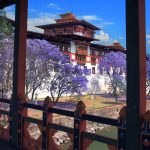12 Places to Visit in Kibber Village: Kibber and Closest Tourist Attractions
Gearing up for your vacation in Spiti Valley? Here’s a fun fact, there are 231 villages in Spiti Valley. So, how many are on your list to visit in the Valley?
How about I tell you about a village from where you can visit nearly 10 or more well-known villages within a range of 150 km. Kibber Village is the heart of Spiti Valley. From Serene beauty to wildlife sanctuaries to Monasteries and lakes, Kibber is a paradise for every visitor. These places to visit in Kibber Village are ideal for all kinds of travelers, whether adventure enthusiasts or those who want to break the monotony of everyday life.
So here we have created a travel guide for Kibber Village. Each place to visit in Kibber Village is graced with natural beauty and offers a distinctive experience. Spiti Valley Tour Packages takes you to all the places to visit in Kibber Village and nearby area.
12 Places to Visit in Kibber Village
- Kibber Wildlife Sanctuary
- Hikkim Village
- Langza Village
- Key Monastery
- Kaza
- Tashingang Village
- Rangrik Village
- Nako Village
- Khab Village
- Gette Village
- Kungri Monastery
- Chandra Taal Lake
Let’s discover the Places to Visit in Kibber Village in detail.
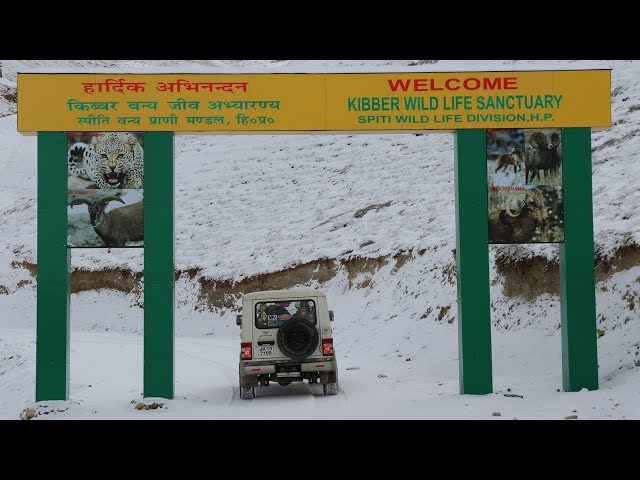
Kibber Wildlife Sanctuary
Kibber Wildlife Sanctuary is home to various endangered wildlife species of high altitudes. This is the only wildlife sanctuary in India located in the cold desert in Kibber Village Spiti Valley.
The show stopper of this wildlife sanctuary is the Snow Leopard. Wildlife photographers and wildlife enthusiasts from all over the world rush to Kibber Village in Winter to capture a glimpse of Snow Leopards as in winter they move to lower altitudes in search of prey. Hence it becomes quite predictable to track their movements. This wildlife place in Spiti Valley is inhabited by other rare and endangered species like ibex, blue sheep, red fox, Tibetan woolly hare, Himalayan wolf, lynx, pika, and Tibetan wild.
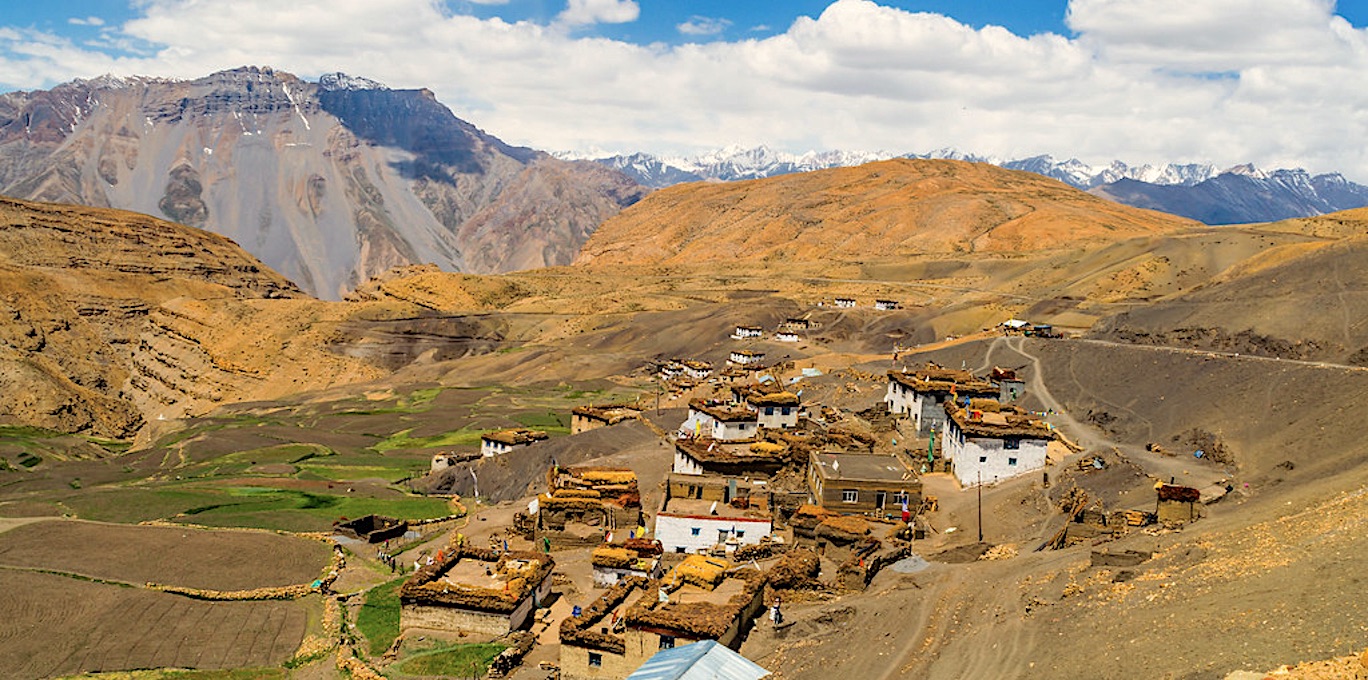
Hikkim Village
Hikkim village in Spiti Valley is recognized as the village with mud houses, prayer flags, and the village that houses the world’s highest post office. It is because of this post office that the village has won accolades all over the world.
Situated at a whooping altitude of 14,400 ft the post office in the village is the only way that the Hikim Village along with other nearby villages is connected with the rest of the world. The postmaster of the post office carries the letters on foot and delivers them to as far as Kaza. This iconic post office is the best place to visit in Kibber Village Spiti Valley do not forget to post a letter to yourself, family members, and friends as this is the best thing to do in Hikkim Village as a piece of memory of a visit to the world’s highest post office.
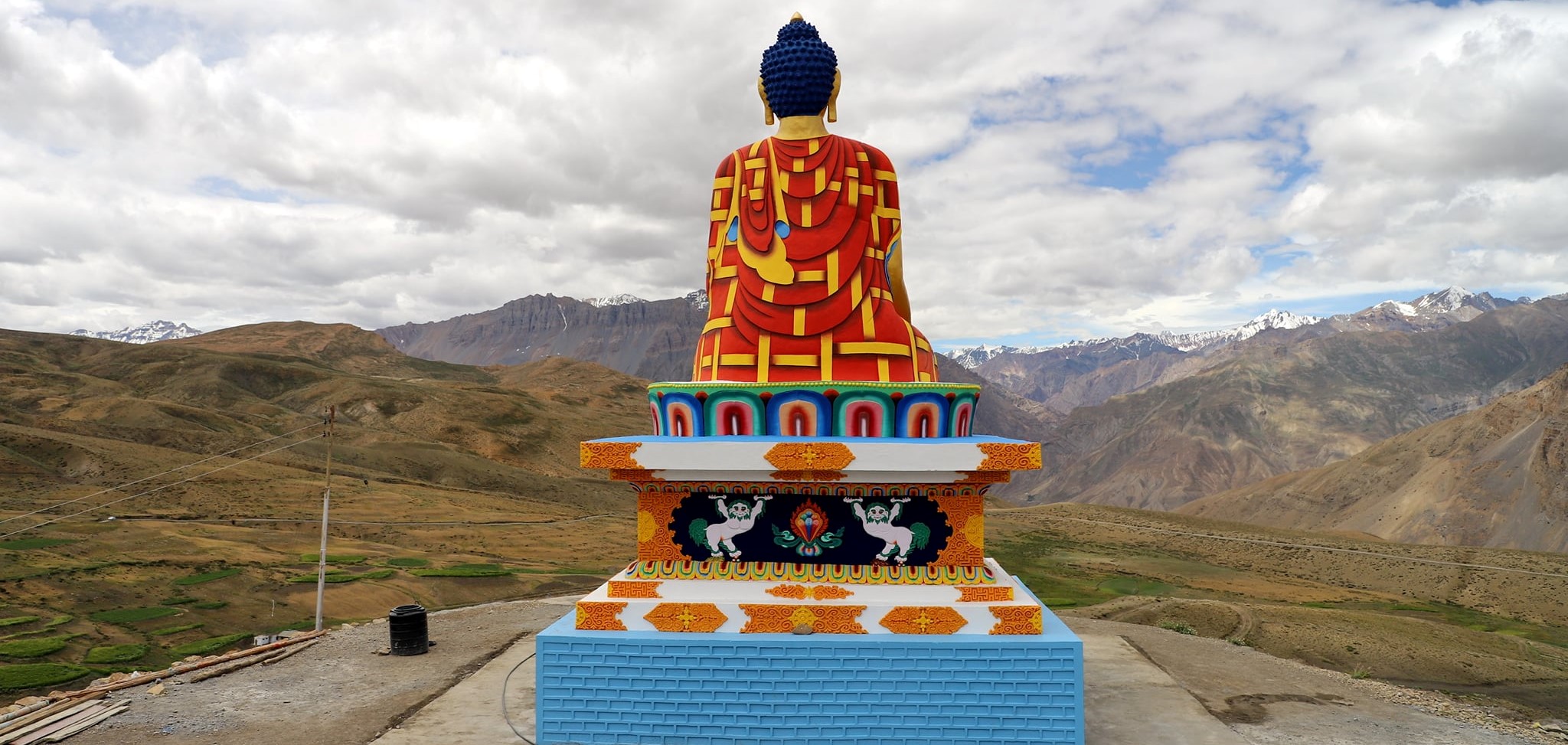
Langza Village
If you see the highest golden Buddha statue from a distance on the way to Kibber Village, you are undoubtedly near the Fossil Village Langza. Langza Village in Spiti Valley is situated at the base of the Chau Chau Nilda mountain also known as Princess Mountain. Millions of years ago even before the Himalayas, Langza village was a part of the Tethys Sea. Due to the movement of tectonic plates and their collision, the Himalayas were formed and subsequently, the Tethys Sea subsided. What was left were the marine animals.
The evidence of this history is proved by the fact that this village has fossils of marine animals underneath the grounds of Langza village which can still be found and excavated. Archeologists and people who are interested in the history of these fossils visit Langza village to research more about them. With the help of locals, tourists can go fossil hunting in Spiti Valley. Langza Village is a place to visit in Kibber Village Spiti to discover intriguing facts about the creation of the Himalayas.
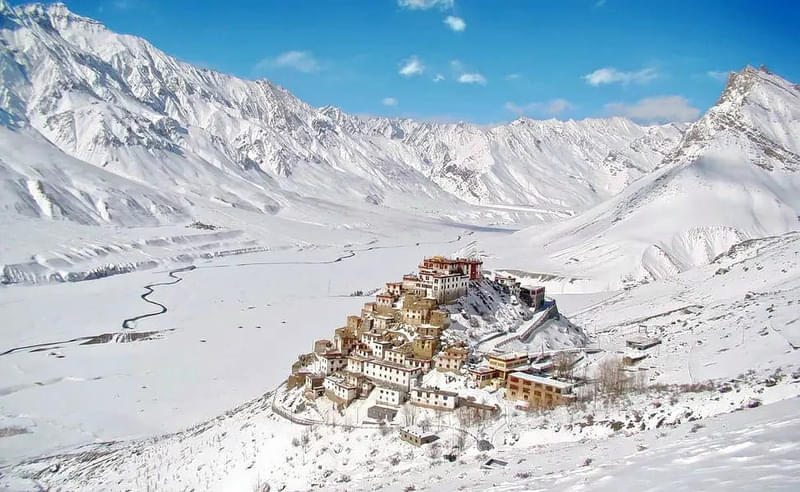
Key Monastery
Key Monastery, believed to be 1000 years old, is the oldest and largest monastery of Lahaul and Spiti Valley. Situated at an elevation of 4.166 meters above sea level, this monastery holds a significant religious center of the Sakya sect of Buddhism in the region. Key Monastery in Spiti Valley also known as the Key Gompa is a pious place to visit in Kibber Village for a spiritual sojourn.
Key Monastery is also the largest training center for Buddhist monks and nearly 200 monks receive their religious teachings here. The Monastery reflects the religious faith of Buddhism through this architectural marvel which is a masterpiece of Indo-Tibetan artworks. The walls and pilar of the monastery are decorated with thangkas, paintings, and murals that depict the life of Lord Buddha and his teachings. The other things that catch the attention of the tourists are the musical instruments and weaponry that are years old and are displayed in the Monastery. These instruments are played during festivals and religious gatherings.
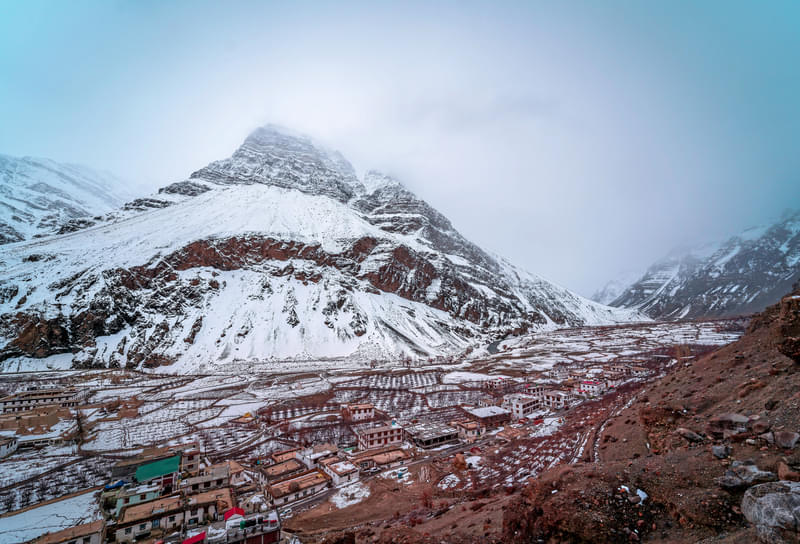
Kaza
Kaza in Spiti Valley is a big city amidst all the small villages. Kaza serves as a hub for all of the major attractions in Kibber Village and the surrounding area. Kaza is a place where all the people from neighboring towns come for shopping, government work, trading, and connecting with big cities like Manali and Shimla. Kaza is the district headquarters of Spiti Valley and is divided into two sections. Old Kaza and New Kaza.The old Kaza has a market, cafes, hotels, and resorts new Kaza is primarily for government offices.
The jewel of Kaza is Key Monastery, which is a major monastery of the region and is situated at the hilltop. The places to visit in Kibber Village Kaza’s main market are the cafes which are the one-stop destination for all the travelers traversing their way through Kaza. The cafe-like Sol Cafe and Himalayan Cafe offer tourists a peek into the culture and tradition of Spiti Valley via their delectable local food of Spiti. These are also the meeting places for fellow travelers to meet and share their experiences of the valley.
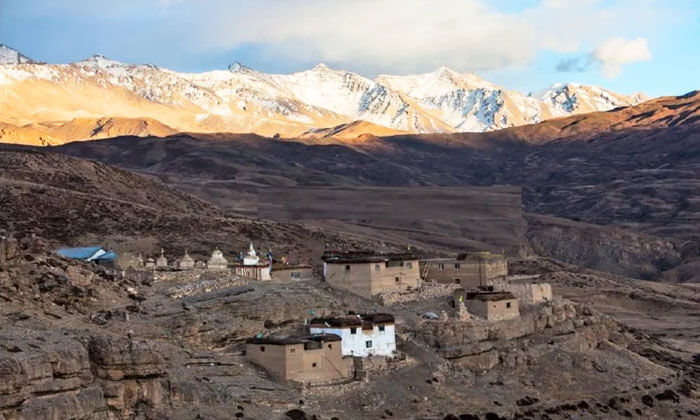
Tashigang Village
The only village in Spiti Valley that is still obscure and is the least explored and visited is Tashigang Village in Spiti Valley. Ancient chortens at the entrance of the village, four mud houses, Tashigang Monastery at the confluence of Satluj River and Spiti River, and the immaculate view of the surrounding mountains, altogether narrate the Tashigang Village.
Ancient Buddhist Chortens hold special religious significance and describe the life of Lord Buddha. It is believed that meditation at these chortens calms the mind and fills the atmosphere with positivity. This peaceful and spiritual place to visit in Kibber Village is a rejuvenating experience.
As you enter the village you may discover it to be deserted as you can hardly find any people around. The village is inhabited by hardly 30-40 people and they largely depend on agriculture for their livelihood.
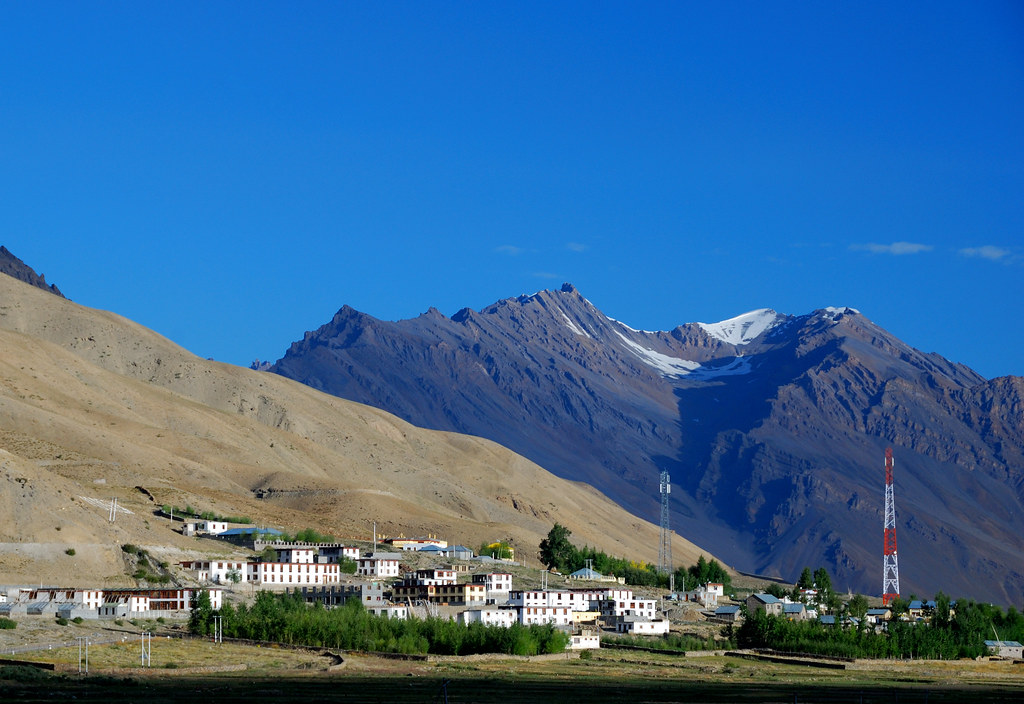
Rangrik Village
Rangrik is a small village but quite large compared to other villages of Spiti Valley. Rangrik Village in Spiti Valley is just 6 km from Kaza and has a population of about 900 people. This is a quiet and peaceful place to visit in Kibber Village away from the crowd of Kaza. Rangrik village has all the basic medical facilities and schools as well. The Buddha status and prayers on the walls are a common sight in Rangrik village.
The village’s main attraction is a cave across a dam and the Magnetic Stone. This cave is only 6 feet by 6 feet and includes all of the amenities essential for a person to live. Bed, stove, prayer space, and study table. It is thought that a monk used to reside and meditate in this cave. The mystery stone with magnetic capabilities draws people’s interest. This stone is raised in a standing posture, and when you set a coin on it, it attaches to it as if it were a magnet.
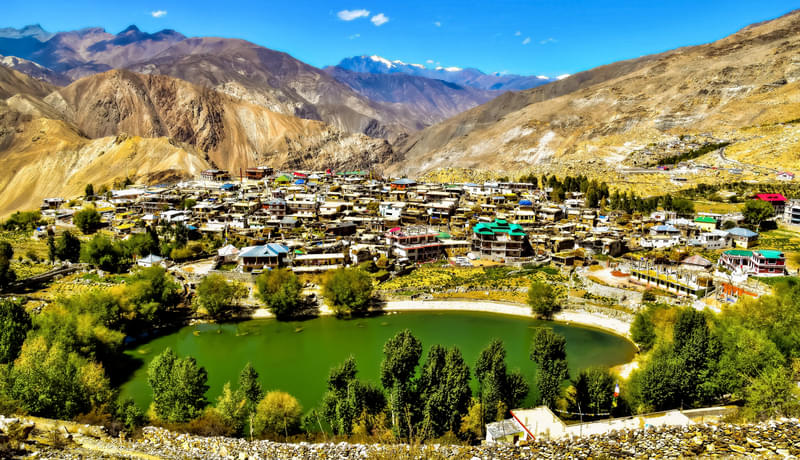
Nako Village
Situated 130 km from Kibber Village is a quaint Nako Village, which is the last village of the Kinnaur district and is away from the hustle and bustle of many tourists because of its low popularity. Being in the remote part of the district, getting connected with the world is a challenge. It is also a boom to be away from all the connections and spend time in solitary. There isn’t much to do in the village except to stroll around the lanes and have a heartfelt chat with the locals of the village. It is the place in Kibber Village where you can just spend time watching nature in its glory.
The 11th-century Buddhist Gompa is the main attraction of the Village to the Nako Village. The Monastery can easily be located settling in between the mud old houses and a bright-colored gate that defines the ancient architecture. The Nako Lake holds the beauty of the village with its serene setting.
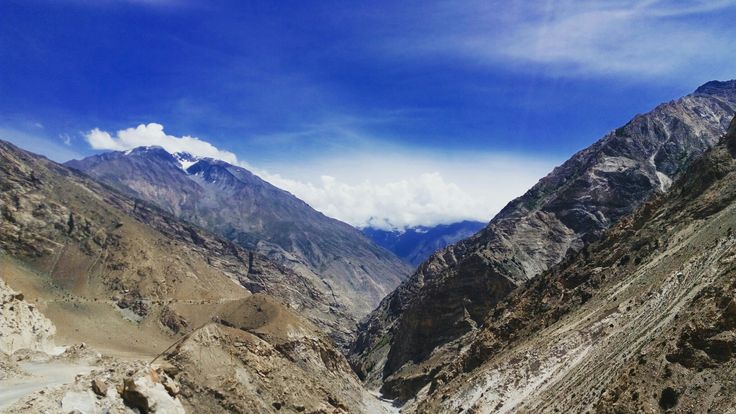
Khab Village
Khab Village is well known for the Khab Sangam. This small village in Spiti Valley is close to the India-Tibet border and is situated at the confluence of the Spiti and Satluj rivers. The Spiti River flows through the Spiti Valley and meets the Sutlej, which originates in Tibet’s Mansarovar Lake. Khab Sangam, located in Himachal’s Kinnaur region, is surrounded by enormous mountains on all sides.
Khab Sangam emerges where the Spiti and Setluj rivers meet on the left, while a historic silk route between India and Tibet and a significant commercial road can be observed on the right. The Sangam is guarded by two mountains on both sides that make the place picturesque and enigmatic.
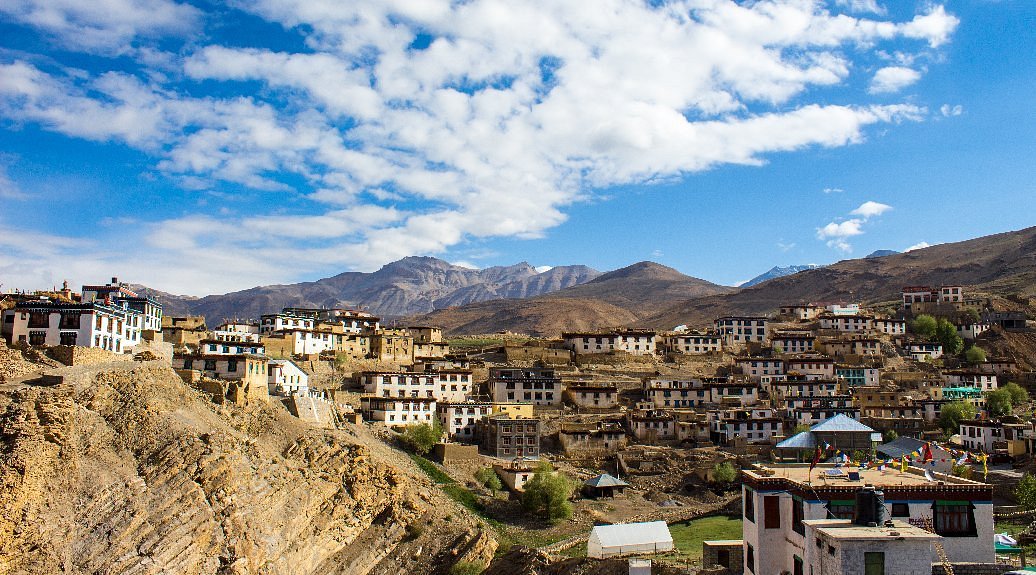
Gette Village
Gette is a little village along the road to Tashigang and 10 km from Kibber. It’s gorgeous, with only two mud houses and a few water bodies that add to the charm of the Village amid large valleys and meadows. The village looks mesmerizing with the surrounding mountain peaks. To get to the village tourists will have to trek 1 km from the main road.
At the top of the village, can enjoy the bird’s eye view of the nearby villages of Hikkim, Lanza, and Key Monastery. Since the area lies near Kibber Wildlife Sanctuary spotting of Ibex, the Spitian Deer is common here. There isn’t much to do around the village except to immerse in the beauty and calm surroundings.
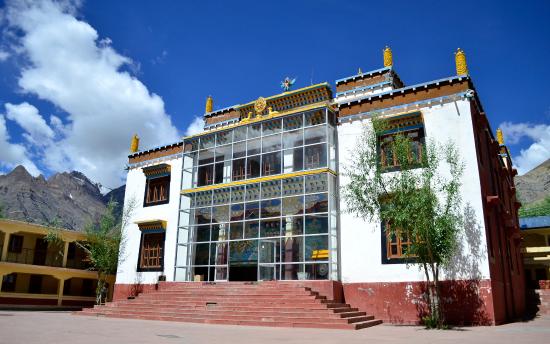
Kungri Monastery
Kungri Monastery is the second oldest monastery in Spiti Valley, behind Tabo Monastery in Tabo village. This monastery, built in 1330, is regarded as the oldest and best religious place to visit in Kibber Village. This is the world’s sole monastery that practices Nyingmapa Buddhism. When visiting the Kungri Monastery, take the time to adorn both the new and old monasteries, since both are worth seeing. While the new Monastery features contemporary construction, the old one is decorated with historical paintings and manuscripts. The monastery’s old structures and peaceful environment offer insight into Tibetan Buddhism’s many traditions and culture.
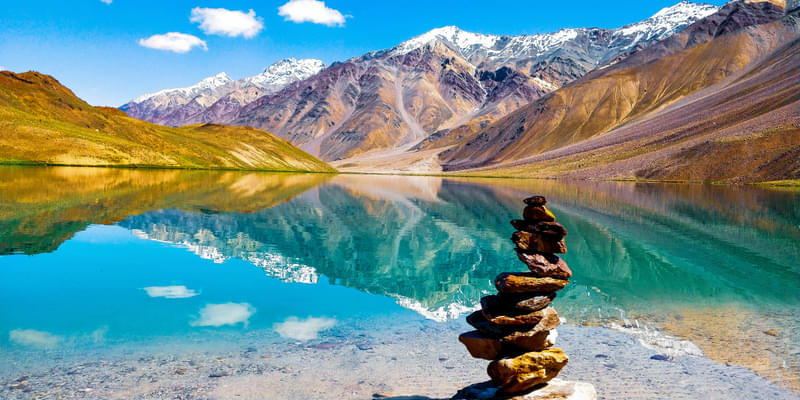
Chandra Taal Lake
Chandra Tall Lake also known as the Moon Lake due to its crescent shape is a splendiferous and mysterious lake. There are several religious myths about Chandra Taal Lake. One of the religious myths relates to Mahabharatha when the Pandavaas in their exile were gradually separated from their souls, and Yudhishtra died at Chandra Taal Lake. Lord Indra came on his Chariot and carried his soul to heaven. Lake is considered sacred to locals due to this belief.
Chandra Taal Lake in Spiti Valley is situated at an altitude of 14,100 feet above sea level and the most intriguing feature of the Lake is that it changes color as the day passes. The lake is 2.5 km wide and is the source of the Bhaga River and is completely frozen during winter. The lake is a popular camping destination and travelers are awed by the blue color of the lake spend some days near the lake appreciating the beauty of the lake with the Himalayas at the backdrop creating a dreamy destination.

The best time to visit Kibber village
The best time to visit Kibber Village is in the summer season. From May to September the temperatures in Spiti Valley are ideal for exploring the places to visit Spiti Valley. Spiti Valley is visited by most of the adventurer’s enthusiasts for camping and trekking activities which can be performed only during the summer season because of the pleasant weather conditions. During the winter, most of the paths leading to Kibber Village and other villages in Spiti Valley are inaccessible owing to heavy snowfall, which makes reaching the destination challenging.
How to reach Kibber village
By Air: The nearest airports near the Kibber Village are the Chandigarh Airpot and Kullu-Manali Bhuntar Airport.
By Train: The nearest major railway station closest to Kibber Village are Shimla and Chandigarh railway stations. Only toy train that departs from Kalka railway station stops at Shimla railway station.
By Road: There are two routes to Kibber Via Manali and Via Shimla. The Shimla route is accessible throughout the year and is the longer route. However, the Manali route is shorter but this route is closed for half of the year during the winter.
By Trek: To add an adventurous element to the vacation, opt for the trek from Kaza to Kibber Village. This trek route can be accomplished within two days with a night halt at Hikkim Village or Langza. This trek route takes you from Hikkim to Lanza and then to Kibber.
Suggested Read: How to reach Spiti Valley
Places to stay in Kibber Village
There are a handful of options available for staying in Kibber Village. Kibber is a popular tourist place because of Kibber Wildlife Sanctuary hence stay options in Kibber village are available for all kinds of travellers. Tourists can book luxury hotels and resorts for a comfortable stay. There are also homestays for those who wish to experience the culture, tradition, and Spitian lifestyle. Hostels and dormitories are also available for backpackers and solo travelers.
What is the best time to visit Kibber village?
The ideal time to visit Kibber Village is between May and September. During these months, the temperature in the area ranges from 20 to 25 degrees Celsius. The severe winters are over by now, and all routes leading to the village are accessible. The climate is also suitable for outdoor activities such as exploring villages, camping, and trekking.
How can I reach Kibber village from the nearest town or city?
The nearest town to Kibber is Kaza, which is 19 kilometers away. There are several alternatives for getting to Kibber from Kaza. Tourists can choose a hiking path that takes them via Hikkim, Langza, and lastly Kibber. Kibber is also accessible by a motorable route for motorcycles and cars. Himachal tourism buses also operate from Kaza to Kibber and are the most affordable option. They do, however, have set hours of operation, so travelers must keep track of when they are operating.
What are the main attractions or points of interest in Kibber Village?
Kibber Village’s major attractions include the Kibber Wildlife Sanctuary and the Key Monastery. Kibber Village is also surrounded by several villages that are a few miles apart. The villages include Langza, Hikkim, Nako, Gette, Tashigang, Rangrik, and Khab Village. All of these tourist attractions may be seen during a visit to Kibber Village.
Are there any trekking routes or outdoor activities available around Kibber village?
Several trek routes from Kibber Village are enroute to different villages of the Spiti Valley. The most popular trekking routes are from Kaza to Kibber and Kibber to Tashigang Village. The trek paths are suitable for both beginners and experienced hikers. Visitors may also enjoy outdoor camping at Chandra Taal Lake, which is the best thing to do near Kibber Village.





